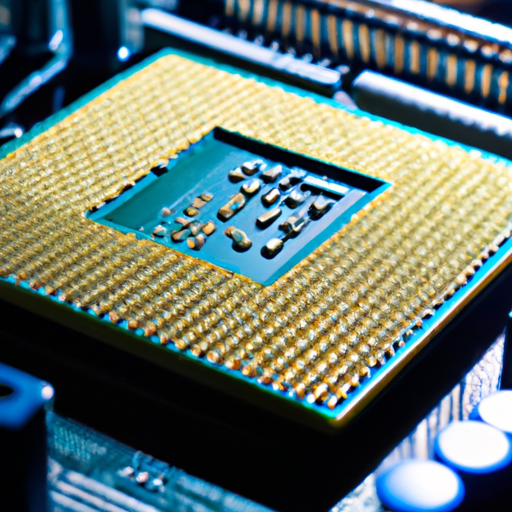Nvidia recently introduced a new processor called the DPU, which stands for Data Processing Unit. These DPUs are powerful processors specifically designed for data processing and are capable of optimizing data center performance through line-rate processing. They offload infrastructure functions, such as intrusion detection and network traffic inspection, for greater efficiency and cost savings in data centers. The DPU revolutionizes virtualized storage and networking environments by offering improved efficiency, power savings, and increased performance. With Nvidia’s BlueField DPU, which is a system on a chip (SoC) with high-performance processing capabilities, the potential for advanced applications like AI is also highlighted. By introducing the DPU, Nvidia is changing the game for data centers, enabling them to keep up with the ever-increasing demands of modern technology.
In a recent video, NetworkChuck shares his experience with Nvidia’s data center, where he explores the DPU and emphasizes its significance. He describes how the CPU and GPU have now been joined by the DPU, a new powerful processor designed for data. Chuck explains the challenges faced by CPUs in managing virtual machines and the increasing demands of networking and security functions. He then introduces the smartnic as a solution that offloads some of these tasks from the CPU. However, as technology advances, the smartnic alone may not be enough, which is where the DPU steps in. Chuck showcases Nvidia’s BlueField DPU, a high-performance system on a chip, and emphasizes the potential of DPUs for optimizing data center performance and handling specialized workloads like AI. The DPU is shown to significantly improve efficiency, power savings, and performance, revolutionizing data center infrastructure.
Introduction
In the ever-evolving world of technology, the need for efficient data processing has become increasingly crucial. Enter the Data Processing Unit, or DPU. In this article, we will explore the concept of DPUs, their features, and the benefits they offer. We will also delve into the role of DPUs in data center infrastructure, their integration into virtualized storage and networking environments, and their impact on AI workloads. Additionally, we will discuss scaling and performance capabilities of DPUs, and provide resources for further exploration. By the end of this article, you will have a comprehensive understanding of the DPU and its potential applications.
What is a DPU?
Definition
A Data Processing Unit, or DPU, is a powerful processor specially designed for data processing. It is a separate endpoint device that can handle tasks such as intrusion detection, network traffic inspection, and other infrastructure functions. DPUs are distinct from traditional CPUs (Central Processing Units) and GPUs (Graphics Processing Units) due to their focus on data-centric computing.
Features
DPUs offer programmability and customization through software development kits like Nvidia’s Doca SDK. This allows developers to tailor the DPU’s capabilities to the specific needs of their applications. Additionally, DPUs provide high-performance processing capabilities and are capable of line-rate processing, resulting in faster data transfer speeds.
Benefits
There are several key benefits to using DPUs in data processing. Firstly, DPUs offload infrastructure functions from the CPU, resulting in greater efficiency and cost savings. By handling tasks such as network traffic inspection, DPUs alleviate the burden on the CPU, allowing it to focus on other high-priority tasks. This offloading of tasks to the DPU improves overall system performance and optimizes data center operations.
Secondly, DPUs play a vital role in improving cybersecurity in data centers. With their ability to handle functions like intrusion detection, DPUs enhance the security infrastructure of data centers, protecting against potential threats and vulnerabilities. By offloading security-related tasks to the DPU, the CPU is freed up to perform other critical functions.
Lastly, DPUs offer scalability and performance capabilities that are essential for modern data centers. DPUs can handle data processing tasks at incredibly high speeds, with the capability to scale up to 400 Gigabits per second. This scalability ensures that data centers can keep up with the ever-increasing demands of data processing and transfer.
DPU and Data Center Infrastructure
Overview of DPUs in Data Centers
DPUs are revolutionizing data center infrastructure by offloading numerous tasks from the CPU, resulting in improved efficiency and performance. DPUs are integrated into data center architectures to handle functions such as network traffic inspection, protocol offload, storage acceleration, and more. By offloading these tasks to the DPU, data centers can achieve higher overall system performance and enhance their infrastructure capabilities.
Nvidia’s BlueField DPU
One of the leading DPUs in the industry is Nvidia’s BlueField DPU. The BlueField DPU is a system on a chip (SoC) with high-performance processing capabilities. It is designed to handle a wide range of data processing tasks, including networking, security, and storage acceleration. The BlueField DPU’s integration into data center infrastructure allows for seamless offloading of tasks from the CPU, resulting in improved performance and efficiency.
Optimizing Data Center Performance
DPUs play a crucial role in optimizing data center performance. By offloading tasks such as network traffic inspection and protocol offload to the DPU, data centers can achieve line-rate processing, ensuring faster data transfer speeds and reduced latency. This optimization of data center performance leads to improved overall system efficiency and enhanced user experience.
Improving Cybersecurity in Data Centers
DPUs are instrumental in improving cybersecurity in data centers. With their ability to handle tasks such as intrusion detection and network traffic inspection, DPUs enhance the security infrastructure of data centers. By offloading these security-related functions to the DPU, data centers can strengthen their defenses against potential threats and vulnerabilities, ensuring the safety of valuable data.
DPU in Virtualized Storage and Networking Environments
Introduction to Virtualized Storage and Networking
Virtualized storage and networking environments have transformed the way data centers operate. By virtualizing physical servers and network components, data centers can consolidate resources and improve overall efficiency. Virtualization allows for greater flexibility, scalability, and resource optimization.
Benefits of Using a DPU
The use of DPUs in virtualized storage and networking environments provides several benefits. Firstly, DPUs offload tasks such as network traffic inspection and protocol offload from the CPU, resulting in increased efficiency and faster data transfer speeds. This offloading ensures that critical functions within the virtualized environment can be performed without straining the CPU.
Additionally, DPUs enable enhanced security capabilities within virtualized environments. By handling functions such as intrusion detection, DPUs strengthen the security infrastructure of virtualized storage and networking environments, protecting against potential threats.
Compatibility with VMware vSphere 8
DPUs are fully compatible with VMware vSphere 8, a leading virtualization platform. With VMware vSphere 8, DPUs can be assigned to virtual machines using Universal Pass Through (UPT). This compatibility ensures seamless integration of DPUs into virtualized environments, enabling efficient and secure data processing.
Performance Comparison with Network Interface Cards (NICs)
In a test comparing the performance of a regular Network Interface Card (NIC) with a DPU, the DPU showcased significant advantages. The test involved data transfer between Redis servers, and the DPU demonstrated higher bandwidth, lower latency, and higher operations per second compared to the NIC. This performance superiority highlights the potential of DPUs in handling data-intensive tasks within virtualized storage and networking environments.
DPU and AI
DPU’s Role in AI Workloads
DPUs are transforming the game for AI in data centers. With their high-performance processing capabilities, DPUs are well-suited for handling AI workloads. By offloading tasks such as deep learning inference or data preprocessing to the DPU, data centers can achieve faster AI processing and improved overall performance.
Specialized DPUs for Advanced Applications
Leading-edge AI applications require specialized DPUs to handle the complex demands of the workloads. These specialized DPUs offer enhanced capabilities and programmability, enabling data centers to optimize AI performance. By utilizing specialized DPUs, data centers can unlock the full potential of advanced AI applications.
Scaling and Performance
Scaling Up to 400 Gigabits per Second
DPUs offer exceptional scalability, with the capability to scale up to 400 Gigabits per second. This scalability ensures that data centers can handle increasing data processing demands, accommodating rapid growth and data transfer requirements.
Performance Test on a 25 Gigabit per Second Cluster
In a specific performance test, a 25 Gigabit per second cluster was used to evaluate the DPU’s capabilities. The test demonstrated the DPU’s ability to handle data processing tasks at high speeds, achieving optimal performance and efficiency.
Impact on CPU Performance
Despite the high performance of DPUs, the CPU is not stressed or overwhelmed. The offloading of tasks to the DPU allows the CPU to focus on other critical functions, ensuring efficient multitasking within the data center. This separation of workload between the CPU and DPU results in improved overall system performance.
Exploring Nvidia’s White Papers
Additional Resources for Understanding DPUs
For readers interested in delving deeper into the capabilities of DPUs, Nvidia offers a range of white papers that provide comprehensive information. These white papers explore various aspects of DPUs, including their benefits, integration into data center infrastructure, and their impact on AI workloads. These resources serve as valuable references for gaining an in-depth understanding of DPUs.
Deeper Dive into DPU Capabilities
To further understand the capabilities of DPUs, readers are encouraged to explore Nvidia’s white papers on the topic. These resources provide detailed insights into the functionalities and potential applications of DPUs, aiding in comprehensive knowledge acquisition.
Conclusion
In conclusion, DPUs are powerful processors designed specifically for data processing tasks. They are revolutionizing data center infrastructure by offloading functions from the CPU, optimizing performance, and enhancing cybersecurity. DPUs play a vital role in virtualized storage and networking environments, providing benefits such as increased efficiency and improved security. Additionally, DPUs are transforming AI workloads in data centers, with specialized DPUs catering to the demands of advanced applications. Their scalability, performance, and compatibility with leading virtualization platforms make DPUs a significant technological advancement in the data processing landscape. By exploring Nvidia’s white papers, readers can gain a deeper understanding of the capabilities and applications of DPUs, further expanding their knowledge in this evolving field.













